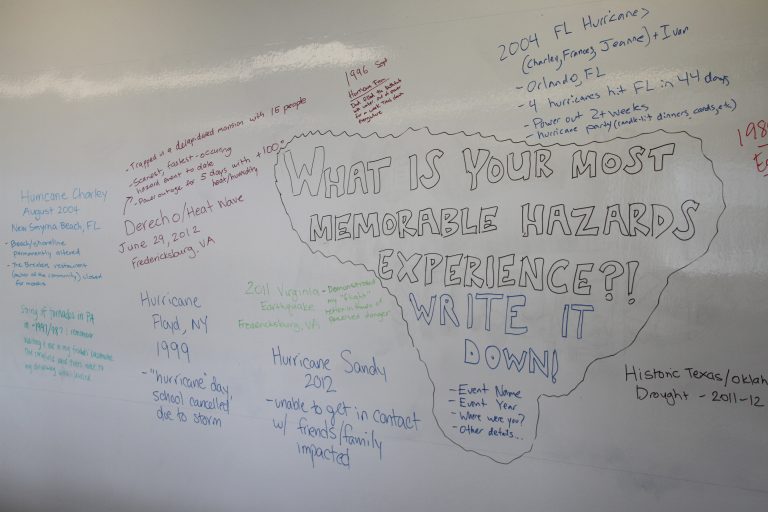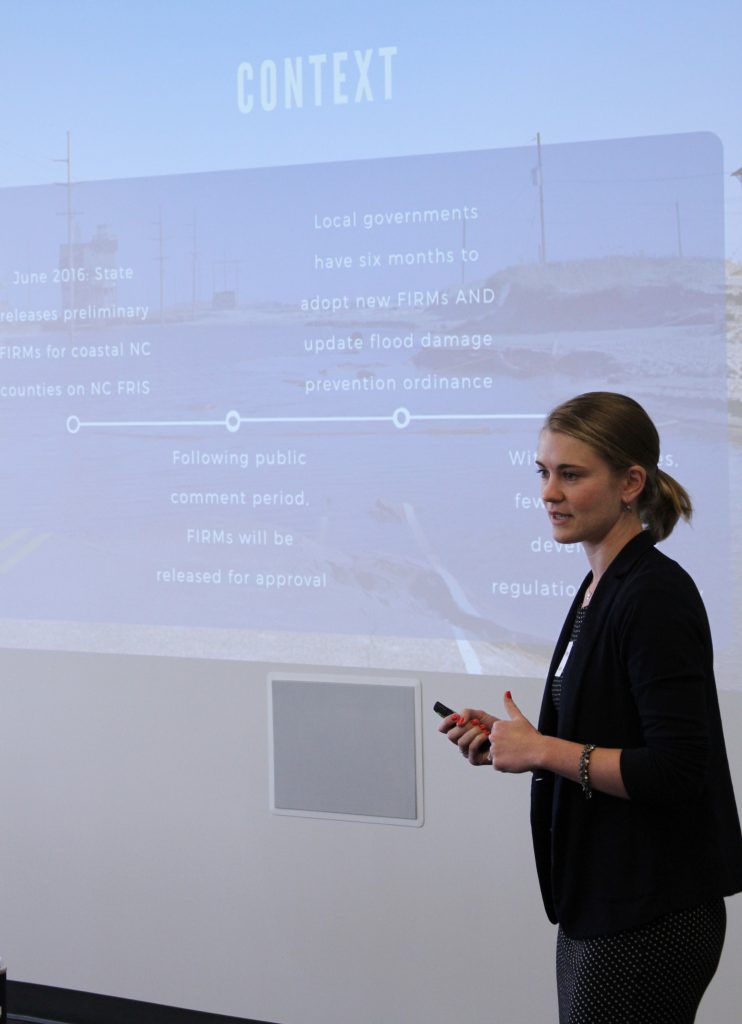Students from three central North Carolina universities – the University of North Carolina at Chapel Hill (UNC-CH), North Carolina State University (NCSU) and Duke University – met last month at a student-organized event to present and discuss issues tied to resilience, particularly in coastal areas.

The Triangle Resilience Student Research Symposium, organized by a student group called the Carolina Hazards and Resilience Planners (CHRP), also brought together researchers from UNC-CH and NCSU, as well as employees from federal agencies. CHRP is a student group started by recent UNC-CH Department of City and Regional Planning graduate Ashton Rohmer, one of three Department of Homeland Security Science & Engineering Workforce Development Grant (WDG) recipients hosted by the Coastal Resilience Center of Excellence (CRC).
“I was thoroughly impressed with the breadth and quality of the student research projects, and am truly grateful for the valuable insights offered by our panelists,” Rohmer said. “I was especially inspired to see that so many of the presentations and discussions focused on crucial issues related to equity, social vulnerability, and public engagement.
“I hope the event continues in future years as a way to bring researchers and practitioners from the physical and social sciences together – as a way to build Triangle university relationships, highlight student work and address the complexities of professional work in this field, especially given the increasingly challenging political environment and the multitude of climate change impacts we’re seeing.”

The Symposium included two sets of students presenting on their graduate work tied to coastal resilience and three panels of professionals sharing insights from their respective fields. CRC Director Dr. Gavin Smith delivered a keynote presentation, highlighting the efforts of the Hurricane Matthew Disaster Recovery & Resilience Initiative. The Initiative focuses on long-term recovery efforts in six communities in eastern North Carolina impacted by the 2016 hurricane. Many of the students presenting are part of a Natural Hazards Resilience Certificate course load taught by Dr. Smith at UNC-CH, which is a CRC education project.
Laura Blackstone, who is a Federal Emergency Management Agency (FEMA) Community Planning and Capacity Building Recovery Coordination Task Force Coordinator, was among a group of FEMA employees attending the event. She said the students were very thoughtful and creative with their presentations.
“I thought the students did a really good job of exploring how to help communities build in more resiliency in recovery,” Blackstone said.
The presentations included:
- Duke graduate student Devon McGhee focused on the success of property buyout programs in Staten Island, N.Y., after Superstorm Sandy in 2012. Nearly $200 million was spent to acquire properties that we left undeveloped, she said, and her work focuses on how the property use change impacted vulnerability to future storms.
- Rohmer discussed lessons learned in property acquisition post-disaster, using Kinston, N.C., as an example. Kinston is one of the six communities that is the focus of the HMDRRI.
- UNC-CH graduate student Colleen Durfee, another WDG recipient, presented on intersectional vulnerability post-disaster, with a focus on the impacts on women. She pointed to the disparate impacts of disasters experienced by women and the under-representation of women in the disaster recovery workforce.
“Disaster recovery is interdisciplinary,” Durfee said. “Disseminating the importance and unique perspectives that women have is crucial.”
- UNC-CH graduate student Carl Kolosna, also a Natural Hazards Resilience Certificate recipient, presented a report on the impacts of redlining and tree-planting in Durham, N.C., and the related implications for the urban heat island effect.
- On the panel “Working through the current political climate,” N.C. Sea Grant Coastal Communities Hazards Adaptation Specialist Jessica Whitehead; Dr. Jason West, an Associate Professor at the Gillings School of Public Health at UNC-CH; and UNC-CH PhD student Kristen Vitro discussed communicating science to the general public. They spoke specifically of efforts to work with residents of rural eastern North Carolina.
“Most people don’t know a scientist,” Dr. West said. “Building community trust is done through engaging in communities.”
- Emily Hall, a Duke graduate student, presented on the impacts of climate changes to the wine industry of the

From left: UNC-Chapel Hill graduate student Kristen Vitro, UNC-Chapel Hill Professor Dr. Jason West and N.C. Sea Grant Coastal Communities Hazards Adaptation Specialist Jessica Whitehead discussed the role of the political climate on research during the event. Photo by Josh Kastrinsky. North Shore of Long Island, N.Y. In some cases, warmer and wetter years have improved wine outputs, she said.
- Ayse Karanci, a coastal engineering graduate student from NCSU, presented on “Coupling Nature and Human Systems,” focusing on the coastal town of Nags Head, N.C. Her simulation model – which combines physical and economic damage along with perceptions of households – incorporates information about household structure, community attractiveness, the physical environment and storm protection measures.
- The panel “Breaking Down Silos,” featuring Dr. Tom Birkland of North Carolina State University and Dr. Mark Little of the UNC Kenan Institute, focused on creating connections between communities during and after disasters. The challenge after disasters, Dr. Birkland said, is that people often cluster with those they know, and that different groups have different measures of success in recovery. Dr. Little said connections with businesses and community organizations are important for recovery, and learning to communicate with each group in the vocabulary that is most familiar helps lead to better solutions across groups.
- Katie Connolly, a UNC-CH graduate student, spoke on “Flooding impacts and adaptations among water and wastewater utilities in the U.S.” Her work focuses on the impacts of increased flooding on municipal infrastructure, particularly water utilities, with case studies from across the United States reviewed.

Abigail Moore of UNC-Chapel Hill presents on her master’s project at the Triangle Resilience Student Research Symposium. Photo by Josh Kastrinsky. - UNC-CH graduate student Abigail Moore spoke on floodplain management planning and policy in Dare County, in eastern North Carolina. She focuses on the changes in rated risk for coastal properties and future vulnerability under a 3-foot sea-level rise scenario. More than 60 percent of developed parcels in the county that are rated as vulnerable to the 3-foot scenario are residential; her report recommends tying floodplain management and land use planning processes and to incorporate sea-level rise projections in land use planning.
- In the closing panel, NCSU Professor of Architecture Kofi Boone and UNC-CH American Indian Center Community Engagement Coordinator Christina Theodorou discussed “Addressing Equity in Mitigation & Recovery.” Theodorou said the Lumbee Tribe, whose members live in areas deeply impacted by Hurricane Matthew, have limited capacity to recover but a strong tribal community infrastructure to react to disasters.
“Through human capital, we can know who was doing what on the ground,” Theodorou said. “Disaster recovery isn’t about saving land, saving buildings….it’s about humans.”
Dr. Boone said that learning lessons from disasters if often too limited by viewing success stories.
“We don’t study failure enough,” Dr. Boone said. “You learn more from failure.”
To see some of the presentations, visit http://coastalresiliencecenter.unc.edu/triangle-resilience-student-research-symposium-presentations/. To see more photos, visit the CRC Flickr page.
